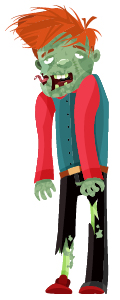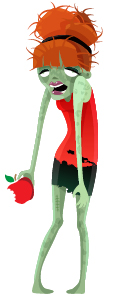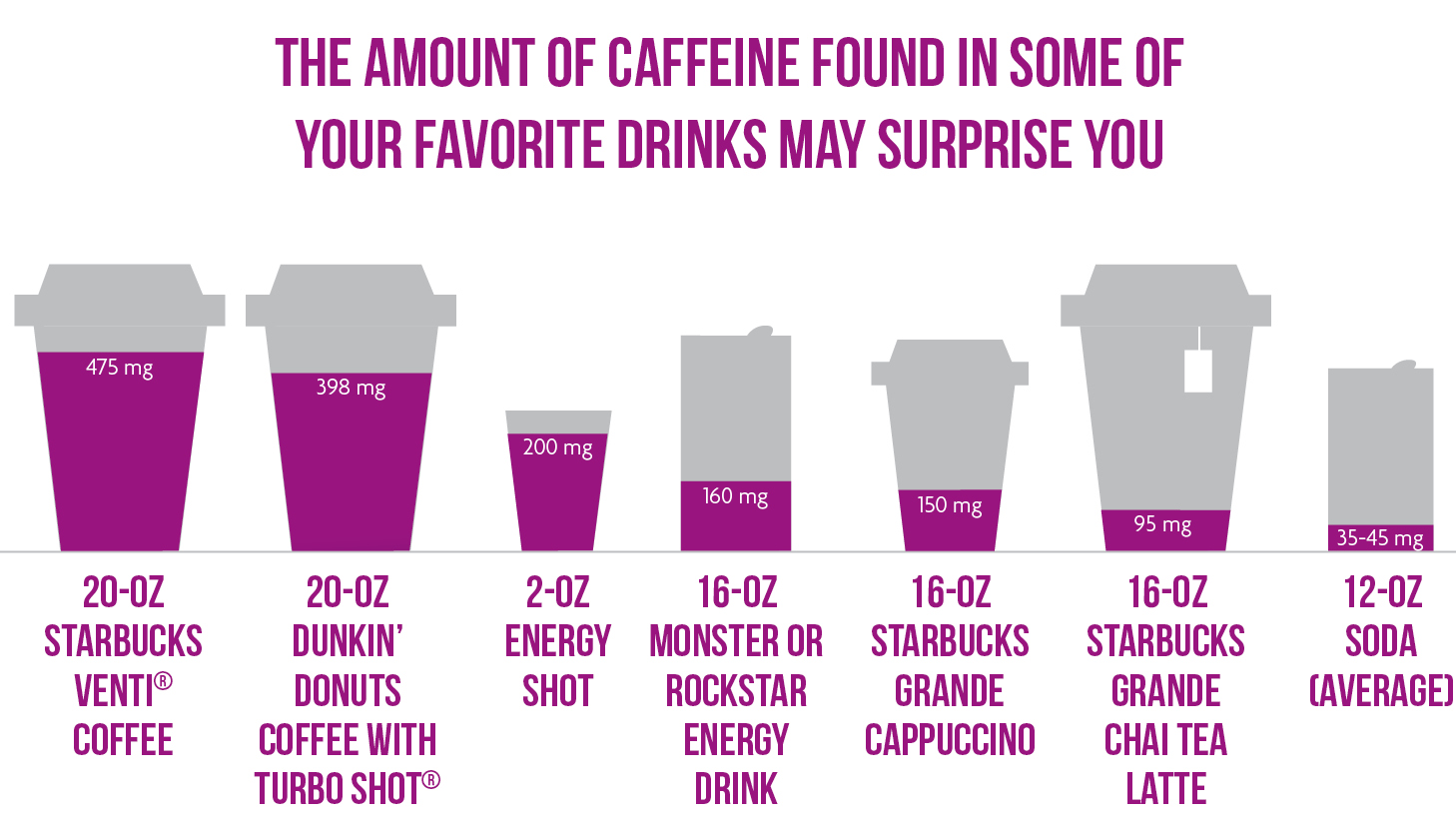
Rate this article and enter to win
If you’ve spent more time with a buzz-inducing cup of coffee than you have with your best friend this week, you’re not alone. Coffee consumption among young adults (ages 18–24) is at an all-time high, according to a report from the National Coffee Association. And it’s not just the joe. Caffeine is everywhere—in tea, soda, energy drinks, and even some types of gum and chocolate.
“Caffeine is widely recognized as a stimulant drug,” says Lisa Y. Lefferts, a senior scientist at the Center for Science in the Public Interest in Washington, DC. That means it temporarily increases energy and alertness. People who drink caffeine very regularly (e.g., daily or multiple times a day) may become “dependent” on it, meaning they need more of it to get the same results and they may suffer mild withdrawal symptoms (e.g., headaches, irritability) if they stop, according to a 2013 review of the literature published in the Journal of Caffeine Research.
Caffeine works by blocking the brain’s adenosine receptors (adenosine is a brain chemical that makes you feel sleepy and sluggish). Preventing you from feeling tired is how it helps fuel your marathon library sessions.
How much is too much?
Caffeine is OK in moderation. Experts say up to 400 milligrams per day is generally considered safe. But all those lattes add up fast, and going over that 400 milligrams mark can be problematic, says Dr. Mary M. Sweeney, an instructor at the Department of Psychiatry and Behavioral Sciences at Johns Hopkins University School of Medicine in Baltimore.
Will caffeine help you ace that test? Maybe
Caffeine isn’t all bad. A jolt of joe can boost your memory power for up to 24 hours, according to a Johns Hopkins University study published in Nature Neuroscience. Participants who were given 200-milligram caffeine tablets after studying a series of images were better at distinguishing them from similar images when tested the next day, as compared to their caffeine-free peers.
You don’t have to drink coffee—just think coffee
Even more interesting? Some research suggests just the thought of downing caffeine is enough to boost your grade on a test. When researchers gave study participants a decaf beverage but told them it was caffeinated, they performed better on tests (just like participants who actually got caffeine), according to the findings published in Psychopharmacology.
Why? The powers of perception around caffeine are strong, says Dr. Candace Dye, assistant director of the pediatric residency program at the University of Alabama at Birmingham School of Medicine. “People think ‘this is the way I’m supposed to act when I drink coffee’ and buy into it.’’
Caffeine’s side effects
The flip side of caffeine is that it can negatively affect your sleep and anxiety levels, and even contribute to panic attacks and blood pressure problems. Here’s how:
It’s a no-brainer that caffeine impairs sleep, but research shows it does more than just keep you from nodding off in class. It can mess up your total sleep schedule because caffeine stays in your bloodstream for up to 10 hours, according to the American Academy of Sleep Medicine. That can be a major problem for students. “It can be easy to get into a negative spiral of using caffeine to try to correct for inadequate sleep, but that caffeine you consume may again prevent you from getting enough sleep,” says Dr. Davis Smith, director of health services at Westminster School in Connecticut. “Occasional caffeine is fine, but adequate sleep is critical to good learning because of how it benefits your concentration and memory.”
The stimulation you get from a shot of espresso can be less than ideal for your anxiety levels. Adolescents who ingested the most caffeine each day had higher scores of anxiety and depression than those who ingested the least, according to a 2016 study published in the Korean Journal of Family Medicine. “Not sleeping enough also leads to worse control of anxiety and depression,” says Dr. Smith.
“Caffeine can increase heart rate and blood pressure, which [can lead] to health problems, including panic attacks and nausea,” says Dr. Jeannie Moorjani, a physician at the Arnold Palmer Hospital for Children at Orlando Health in Florida. While it might sound extreme, ending up in the hospital because of too much caffeine occasionally happens. Dr. Robert Glatter, an emergency physician at Lenox Hill Hospital in New York City, has seen many young patients in the ER who have spiking blood pressure and irregular heartbeats from caffeine overload. “I always ask them what they drank or ate, and a lot of times it’s the caffeine that’s causing these scary symptoms,” Dr. Glatter says.
How to cut back on your caffeine consumption
As with most things, moderation is key. It probably wouldn’t hurt for most of us to cut back on our caffeine consumption—especially if we find ourselves having a hard time falling asleep at night or feeling particularly needy for that next cup.
If you’re ready to reduce your caffeine intake, first do the math. “Coffee is just one of many ways we get caffeine. It’s important to take a look at your whole day to see how much you’re consuming,” says Dr. Dye. If you start your day with a Venti coffee, grab a soda between classes, and sip tea during your evening study session, you’re racking up over 600 milligrams of caffeine—and you may not even realize it.
How to cut back without turning into a zombie
1. Go half and half.
Order a half-caffeinated/half-decaf drink in the a.m. or add more water to your home brew to dilute the caffeine in your daily coffee instead of downing your usual high-octane version, suggests Dr. Sweeney. “Relatively small amounts of caffeine can help relieve withdrawal symptoms, so combining a mostly decaffeinated beverage with a small amount of caffeinated coffee may be a helpful strategy to cut back,” she says.
2. Think small.
A typical travel coffee mug can hold around 14 to 30 ounces on average—that’s anywhere from double to almost quadruple a standard cup of joe! If you take your coffee to go, trade in your oversized travel mug for an 8-ounce single-serving to-go mug.
3. Sneak in a snooze.
To combat the grogginess you’re likely to feel when cutting back on caffeine, take a power nap (as long as it’s before 3 p.m. so it doesn’t mess with your nighttime sleep). A 20- to 30-minute nap can boost mood, alertness, and performance, according to the National Sleep Foundation. Find out more about napping here.
“A quick 20-minute nap always leaves me feeling alert and recharged.”
—Hejer M., first-year graduate student, University of Victoria, British Columbia, Canada
4. Look for low-caf.
Switch up your favorite beverages for something similar but with less caffeine. Swap soda for a green tea kombucha, which typically contains less than 30 milligrams of caffeine, or switch your evening Earl Grey for a caffeine-free herbal tea.
“I tried to fool myself by drinking decaf teas or rooibos teas with milk. I was tired at first, but it worked after a while. I consume less caffeine now.”
—Sophie L., fourth-year student, Queen’s University, Ontario, Canada
5. Say hello to H2O.
Aim to get your water intake to be greater than your caffeinated beverage intake, says Dr. Glatter. If you regularly drink a lot of caffeine, cutting back may mean experiencing some withdrawal symptoms, such as headaches or nausea, but keeping yourself hydrated by drinking lots of water will help. “Every time you think you want a coffee, ask yourself when the last time you drank water was,” says Jewel B., a third-year undergraduate at Villanova University in Pennsylvania. Bonus: Sipping on water will give your hands and mouth something to do when you crave a soda.
“Caffeine is a mild diuretic, which means you’re dehydrating yourself, so you need more water to feel good/normal. It also just makes you feel more alert. [I’ve found] starting my day with a bottle of water can wake me up really fast and hydrate my body after a long night of sleep.”
—Lindsay M., fifth-year undergraduate, Queen’s University, Ontario, Canada
“I drank a lot more water and some drinks without caffeine. Less caffeine generally led to headaches, but my body felt better while I drank more water.”
—Natalie K., second-year student, University of Central Arkansas
 6. Snack smarter.
6. Snack smarter.
Swap a high-protein snack for your caffeine crutch to keep your energy up naturally. Healthy, fatigue-fighting snacks should be rich in protein, fiber, and whole grains (e.g., multigrain toast with nut butter and sliced fruit). Plus, “Eating a healthy, balanced diet will help avoid the hunger that can worsen the effects of caffeine withdrawal,” says Dana Greene, a nutritionist in Massachusetts.
7. Sleep smarter.
Reaching for cappuccino number three can seem like the only way to stay awake through a monster study session. But there’s another solution: sleep. If you can’t fit more hours of sleep into your crazy-packed schedule, focus on improving the quality of the sleep you do get by keeping your bedroom cool (use a fan if you need to) and dark, and switching your phone to night mode to cut down on the blue screen light that can mess with your internal clock. Find more useful sleep tips here.
8. Set a caffeine curfew.
On that note, enjoy your caffeine at least six hours before bedtime to get the sweetest Zs. A dose of caffeine any closer to bedtime can significantly disturb your rest, according to a study published in the Journal of Clinical Sleep Medicine.
9. Explore new ways to stay alert.
Fitness breaks can help you stay perked up while reducing your caffeine quota. Just walking or running up and down stairs for 10 minutes can lower fatigue and boost energy, according to a 2017 study in Physiology & Behavior.
The bottom line: Everyone is affected by caffeine differently, so there’s no surefire way to predict how quitting cold turkey or loading up on large coffees would affect you. Your best bet for cashing in on the benefits of caffeine without any of the health risks is to notice how your body feels when you consume it and try to keep your consumption in check.
Caffeine: US National Library of Medicine
Caffeine content for coffee, tea, soda, and more: Mayo Clinic
Caffeine chart: Center for Science in the Public Interest
The caffeine “detox”: How and why to cut back on your daily fix: CNN
Article sources
Candice Dye, MD, pediatrician and assistant director, Pediatric Residency Program, School of Medicine, University of Alabama at Birmingham.
Robert Glatter, MD, emergency physician, Lenox Hill Hospital, New York, New York.
Dana Greene, RD, LDN, Boston, Massachusetts.
Lisa Y. Lefferts, MSPH, senior scientist, Center for Science in the Public Interest, Washington, DC.
Jeannie Moorjani, MD, pediatrician, Arnold Palmer Hospital for Children, Orlando, Florida.
Mary M. Sweeney, PhD, instructor, Behavioral Pharmacology Research Unit, Department of Psychiatry and Behavioral Sciences, Johns Hopkins University School of Medicine, Baltimore, Maryland.
Academy of Nutrition and Dietetics. (2014). Smart snacks for your trip. Retrieved from https://www.eatright.org/resource/health/lifestyle/travel/smart-snacks-for-your-trip
American Academy of Pediatrics. (2011). Sports drinks and energy drinks for children and adolescents: Are they appropriate? Pediatrics, 127(6), 1182–1189. Retrieved from https:///doi.org/10.1542/peds.2011-0965
Borota, D., Murray, E., Keceli, G., Chang, A., et al. (2014). Post-study caffeine administration enhances memory consolidation in humans. Nature Neuroscience, 17, 201–203. Retrieved from https://doi.org/10.1038/nn.3623.
Center for Science in the Public Interest. Caffeine chart. Retrieved from https://cspinet.org/eating-healthy/ingredients-of-concern/caffeine-chart
Consumer Reports. (2012). The buzz on energy drink caffeine. Retrieved from https://www.consumerreports.org/cro/magazine/2012/12/the-buzz-on-energy-drink-caffeine/index.htm
Ding, M., Satija, A., Bhupathiraju, S. N., Hu, Y., et al. (2015). Association of coffee consumption with total and cause-specific mortality in three large prospective cohorts. Circulation, 132(24), 2305–2315. doi: 10.1161/CIRCULATIONAHA.115.017341
Drake, C., Roehrs, T., Shambroom, J., & Roth, T. (2013). Caffeine effects on sleep taken zero, three, or six hours before going to bed. Journal of Clinical Sleep Medicine, 9(11), 1195–1200. Retrieved from https://dx.doi.org/10.5664/jcsm.3170
Fuligni, A. J., Bai, S., Krull, J. L., & Gonzalez, N. A. (2017). Individual differences in optimum sleep for daily mood during adolescence. Journal of Clinical & Adolescent Psychology, 1-11. Retrieved from https://doi.org/10.1080/15374416.2017.1357126
Foundation for a Drug-Free World. (n.d.). Stimulants. Retrieved from https://www.drugfreeworld.org/drugfacts/prescription/stimulants.html
Harrell, P., & Juliano, L. (2009). Caffeine expectancies influence the subjective and behavioral effects of caffeine. Psychopharmacology, 207(2), 335–342. Retrieved from https://doi.org/10.1007/s00213-009-1658-5
Heffron, T. M. (2013). Sleep and caffeine. American Academy of Sleep Medicine. Retrieved from https://www.sleepeducation.org/news/2013/08/01/sleep-and-caffeine
Jin, M.-J., Yoon, C.-H., Ko, H.-J., Kim, H.-M., et al. (2016). The relationship of caffeine intake with depression, anxiety, stress, and sleep in Korean adolescents. Korean Journal of Family Medicine, 37(2), 111–116. doi: 10.4082/kjfm.2016.37.2.111
Meredith, S. E., Juliano, L. M., Hughes, J. R., & Griffiths, R. R. (2013). Caffeine use disorder: A comprehensive review and research agenda. Journal of Caffeine Research, 3(3), 114–130.
National Center for Complementary and Integrative Health. (2017, October 4). Energy drinks. Retrieved from https://nccih.nih.gov/health/energy-drinks
National Coffee Association. (2017). Daily coffee consumption up sharply [Press release]. Retrieved from https://www.ncausa.org/Portals/56/PDFs/Communication/NCA_NCDT2017.pdf?ver=2017-03-29-115235-727
National Institute on Drug Abuse for Teens (2016, May 10). Is caffeine really addictive? Retrieved from https://teens.drugabuse.gov/blog/post/caffeine-really-addictive
National Sleep Foundation. Napping. Retrieved from https://sleepfoundation.org/sleep-topics/napping
Randolph, D., & O’Connor, P. (2017). Stair walking is more energizing than low dose caffeine in sleep deprived young women. Physiology & Behavior, 174, 128–135. Retrieved from https://doi.org/10.1016/j.physbeh.2017.03.013
Studte, S., Bridger, E., & Mecklinger, A. (2015). Nap sleep preserves associative but not item memory performance. Neurobiology of Learning and Memory, 120, 84–93. Retrieved from https://doi.org/10.1016/j.nlm.2015.02.012
US National Library of Medicine. Caffeine. Retrieved from https://medlineplus.gov/caffeine.html
University of Georgia. (2008). Low-intensity exercise reduces fatigue symptoms by 65 percent, study finds [Press release]. Retrieved from https://news.uga.edu/releases/article/low-intensity-exercise-reduces-fatigue-symptoms-by-65-percent-study-finds/




























